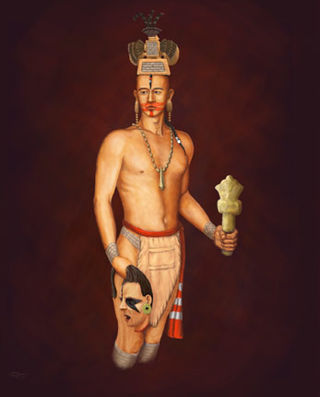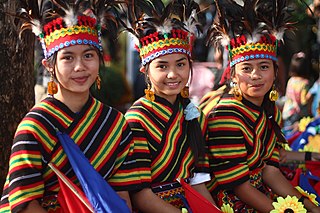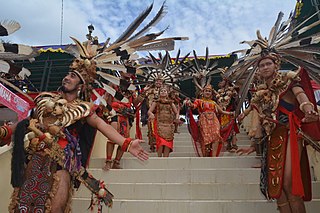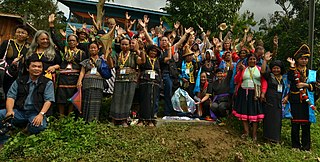Pawnee mythology is the body of oral history, cosmology, and myths of the Pawnee people concerning their gods and heroes. The Pawnee are a federally recognized tribe of Native Americans, originally located on the Great Plains along tributaries of the Missouri and Platte Rivers in Nebraska and Kansas and currently located in Oklahoma. They traditionally speak Pawnee, a Caddoan language. The Pawnees lived in villages of earth lodges. They grew corn and went on long bison hunts on the open plains twice a year. The tribe has four bands: the Skidi and "the South Bands" consisted of the Chawi, the Kitkahahki and the Pitahawirata Pawnee.

The Dayak or Dyak or Dayuh are one of the native groups of Borneo. It is a loose term for over 200 riverine and hill-dwelling ethnic groups, located principally in the central and southern interior of Borneo, each with its own dialect, customs, laws, territory, and culture, although common distinguishing traits are readily identifiable. Dayak languages are categorised as part of the Austronesian languages. The Dayak were animist in belief; however, since the 19th century there has been mass conversion to Christianity as well as Islam due to the spreading of Abrahamic religions.

Headhunting is the practice of hunting a human and collecting the severed head after killing the victim, although sometimes more portable body parts are taken instead as trophies. Headhunting was practiced in historic times in parts of Europe, East Asia, Oceania, Southeast Asia, South Asia, Mesoamerica, South America, West Africa and Central Africa.

Kaharingan is an indigenous monotheistic folk religion of the Dayak people such as Katingan, Lawangan, Ma'anyan, Ngaju, Ot Danum people native to the Central Kalimantan and South Kalimantan region in Indonesia.

The Ibans or Sea Dayaks are an Austronesian ethnic group indigenous to the state of Sarawak and some parts of Brunei and West Kalimantan, Indonesia. The Ibans are also known as Sea Dayaks and the title Dayak was given by the British and the Dutch to various ethnic groups in Borneo island. It is believed that the term "Iban" was originally an exonym used by the Kayans, who – when they initially came into contact with them – referred to the Sea Dayaks in the upper Rajang river region as the "Hivan".

Bidayuh is the collective name for several indigenous groups found in southern Sarawak, Malaysia and northern West Kalimantan, Indonesia, on the island of Borneo, which are broadly similar in language and culture. The name Bidayuh means 'inhabitants of land'. Originally from the western part of Borneo, the collective name Land Dayak was first used during the period of Rajah James Brooke, the White Rajah of Sarawak. At times, they were also lesser referred to as Klemantan people. They constitute one of the main indigenous groups in Sarawak and West Kalimantan and live in towns and villages around Kuching and Serian in the Malaysian state of Sarawak, while in the Indonesian province of West Kalimantan they are mainly concentrated in the northern Sanggau Regency. In Sarawak, most of Bidayuh population can be found within 40 km of the geographical area known as Greater Kuching, within the Kuching and Serian Division. They are the second-largest Dayak ethnic group in Sarawak after the Iban and one of the major Dayak tribes in West Kalimantan.

The Nocte people, also known as the Nocte Naga, are a Tibeto-Burmese ethnic group primarily living in Northeast Indian state of Arunachal Pradesh. They number about 111,679, mainly found in the Patkai hills of Tirap district of Arunachal Pradesh, India. Ethnically related to the Konyak Naga, their origins can be traced back to the Hukong Valley in Myanmar, where they migrated from between the 1670 and 1700.

Pendet dance a traditional dance from Bali, Indonesia, in which floral offerings are made to purify the temple or theater as a prelude to ceremonies or other dances. Pendet is typically performed by young girls, carrying bowls of flower petals, handfuls of which are cast into the air at various times in the dance. Pendet can be thought of as a dance of greeting, to welcome the audience and invite spirits to enjoy a performance. It is one of the oldest Balinese dance, although the current form was codified in the 1950s.

Gawai Dayak is an annual festival and a public holiday celebrated by the Dayak people in Sarawak, Malaysia on 1 and 2 June. Sarawak Day is now celebrated on July 22 every year. Gawai Dayak was conceived of by the radio producers Tan Kingsley and Owen Liang and then taken up by the Dayak community. The British colonial government refused to recognise Dayak Day until 1962. They called it Sarawak Day for the inclusion of all Sarawakians as a national day, regardless of ethnic origin. It is both a religious and a social occasion recognised since 1957.
Hindu traditions right from Ramayan to till date cremate their dear ones, burying the dead is in some sections of society. But the majority of Hindus cremate the dead as they believe that the body is made up of 5 elements which after cremation will mix in the pancha bhootas,
Selakoa.k.a.Selakau, Salako or Silakau are the indigenous people native to the Selakau regions in Sambas Regency of West Kalimantan, Indonesia. Nowadays, the Selako diaspora can be found in the neighbouring Selakau regions as well; including the districts of Pemangkat, Paloh, Tebas, Teluk Keramat, Sejangkung, Sajingan Besar in Sambas Regency, the East Singkawang district in Singkawang, the districts of Tujuh Belas and Samalantan in Bengkayang Regency, and the Lundu district in Sarawak. Selako people are sometimes classified as part of larger Dayaks community, thus sometimes they are called as Selako Dayaks as well. Their native or indigenous language is the Selako language. Like any other indigenous Dayak groups, the Selako people embraced the Kaharingan religion, but many Selakos diaspora tend to have Christians and Roman Catholics faiths after the mass conversion by missionaries in the 19th century.

The Ifugao people are the ethnic group inhabiting Ifugao Province. They reside in the municipalities of Lagawe, Aguinaldo, Alfonso Lista, Asipulo, Banaue, Hingyon, Hungduan, Kiangan, Lamut, Mayoyao, and Tinoc. The province is one of the smallest provinces in the Philippines with an area of only 251,778 hectares, or about 0.8% of the total Philippine land area. As of 1995, the population of the Ifugaos was counted to be 131,635. Although the majority of them are still in Ifugao province, some of them have moved to Baguio, where they work as woodcarvers, and to other parts of the Cordillera Region.

Seren Taun is an annual traditional Sundanese rice harvest festival and ceremony. The festival was originally held to mark the new agriculture year in the Sundanese ancient calendar as well as thanks giving for the blessings of the abundance rice harvest, and also to pray for the next successful harvest. Seren Taun demonstrates the Sundanese agricultural way of life, and is held in high regard in Sundanese traditional villages, as the festival draw thousands Sundanese villagers to participate as well as Indonesian or foreign visitors.
Sarawak's population is very diverse, comprising many races and ethnic groups. Sarawak has more than 40 sub-ethnic groups, each with its own distinct language, culture and lifestyle. This makes Sarawak demography very distinct and unique compared to its Peninsular counterpart. However, it largely mirrors to other territories in Borneo - Sabah, Brunei and Kalimantan.

Traditions of Indonesia are traditions, beliefs, values, and customs that belong within the culture of Indonesian people. Indonesia is a vast country of sprawling archipelago with a diverse demographic range of over 1,300 ethnic groups, and speaking more than 700 living languages.

Indonesian martial arts includes a variety of fighting systems native to or developed in the archipelago of Indonesia, both the age-old traditional arts, and the more recently developed hybrid combatives. In the Indonesian language the term bela-diri is used to mean martial art, and in essence the Indonesian fighting arts are meant as one's defence against perceived threat and assault. Other than physical training, they often include spiritual aspects to cultivate inner strength, inner peace and higher psychological ends.

Ngajat is popular family of dances among the Iban people in Sarawak, Malaysia; Temburong District, Brunei and West Kalimantan, Indonesia.

Momolianism is a belief system of the Kadazan-Dusun people of Sabah.
The Ibans or Sea Dayaks are a branch of the Dayak people on the island of Borneo in Southeast Asia. It is believed that the term "Iban" was originally from the Kayan Language. "Iban" or "Hivan" means human or person.

Sarawakian cuisine is a regional cuisine of Malaysia. Like the rest of Malaysian cuisine, Sarawak food is based on staples such as rice. There is also a great variety of other ingredients and food preparations due to the influence of the state's varied geography and indigenous cultures quite distinct from the regional cuisines of the Peninsular Malaysia. Sarawak is famous for its multi-ethnic population. As the homeland of many unique communities, Sarawak has a variety of cuisines rarely found elsewhere in Malaysia. The uniqueness of Sarawak well depends on its ethnic groups. Every native group in Sarawak has their own lifestyle, traditions, cultures and also foods. Sarawak cuisine is less spicy and has a subtle in taste. It uses fresh seafood and natural herbs like turmeric, lemongrass, ginger, lime and tapioca leaves. These ingredients are not only easily available, but also add a hint of aroma, texture and freshness to the delicacies. Food is one of the most cultural identities for native groups in Sarawak with each ethnic group having their own delicacies. Among the Iban, popular foods include tubu (stems), tuak and pansuh. The Malay have bubur pedas (porridge) and kek lapis Sarawak ; the Bidayuh have asam siok and sup ponas Bidayuh. The Melanau make tebaloi, sagu and umai and the Orang Ulu are known for garam barrio, kikid (broth), tengayen, and urum giruq (pudding).














